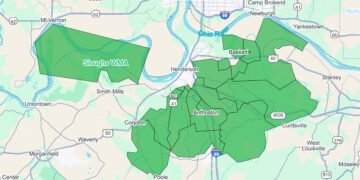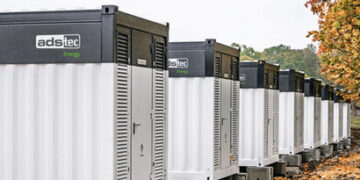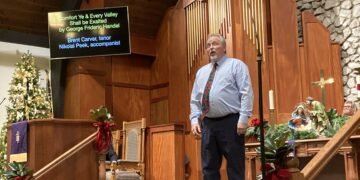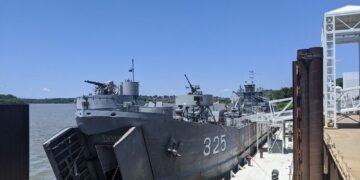Editor’s note: Today, Sunday, Dec. 10, 2023, marks the two-year anniversary of the tornadoes that ravaged parts of western Kentucky. Henderson Office of Emergency Management Director’s Assistant Jill Ward was a volunteer for the agency then. She logged countless hours in the aftermath of the tornado. Here is her account of what was seen in Dawson Springs during that time.
December 10, 2021, started as just another beautiful 70-degree day in the neighborhood, but this day had a much more devastating outcome than many could have imagined. National and local weather forecasters were tracking cells that they anticipated to be potential tornados on the ground in the wee hours of the night, therefore all departments of first responders were placed on a heightened alert status.
Unfortunately, the forecasters were right. There were multiple tornados that night, but one turned out to be an EF-4 with winds in excess of 190 miles per hour traveling at 55-plus mph. It stretched over a mile wide in some areas and came from down-south keeping a consistent spin on the ground for about 240 miles, starting in Arkansas, spanning through Tennessee and ending in Kentucky. After the tornado’s passage, news stations reported the widespread damage that took out infrastructure, homes and businesses, and claimed numerous lives.
Starting at approximately 9 pm for two hours, this aggressive tornado traveled across eight counties in Western Kentucky and had first responders quickly in motion following it. From the discovery of human remains to medically treating the injured survivors, the effort would take a mental and physical toll, but it would not be a challenge these people weren’t ready to handle. Fire departments, law enforcement, medical services, various emergency management agencies and search and rescue were some of the first on scene of Dawson Springs, population approximately 2,600.
Upon arrival, construction of the staging area and command post was underway and ample people were already bringing supplies of food and water. Law enforcement was directing traffic while road and utility crews and volunteers were clearing debris for emergency vehicles to get through. Some of the hurdles everyone ran into initially were having no cell-coverage, Wi-Fi or electricity. The lack of communication made for a lot of guesswork for people unfamiliar with the area, but it was almost instantaneous that they were aided by those who lived there, whether they were survivors in the path of the tornado or residents less impacted by it.
With no streetlights or home porchlights to illuminate the area and using only flashlights, SAR team members cautiously made their way through uprooted trees and a landscape of mixed debris consisting of building materials, household goods, vehicles and personal belongings. Shattered glass and rain-drenched photos that littered the streets told the traumatic stories of so many families. Making their way through the rubble and knocking on any structure(s) still standing, the team called out to anyone within the sound of their voices, hoping to get a response from survivors. They then spray-painted standardized symbols on doors/structures to document that the structure had been searched, hazards noted and if any injured/deceased persons were located. Additionally, during the ground search some cars were flipped upside down and damaged on all sides, showing the tale of the destructive force of the tornado. A few people were found taking shelter from the rain and cold in their destroyed vehicles.
As dawn approached, a drone was utilized to assist with situational awareness of the damaged areas to help look for additional survivors and deceased victims using its high-resolution camera equipped with thermal capabilities.
Local and national news stations began reporting on the devastation and the numbers of injured and lives lost that this tornado left behind. Viewers saw their fellow human beings in desperate need and responses started almost immediately. A clean-up began by mid-day when various heavy equipment, trucks and crews started arriving to clear and haul away debris and repair and replace damaged infrastructure.
Donations of material goods came in by numerous supply stores like Home Depot, Lowes and Tractor Supply Co. They gave gloves, chainsaws, gas cans, shovels and more—anything that would aid these hard-working people to do this difficult task.
Damage assessment efforts began the next day. Residents standing outside of what used to be their home were still in a sort of shock as they were trying to find anything useful or precious to salvage from the rubble. Some stated that the tornado went through their home in 10-15 seconds, and it was gone just like that, in the blink of an eye. They were made homeless that quickly.
The American Red Cross began the process of setting up shelters for survivors while organized volunteer groups began delivering basic first-aid, household supplies, hygiene products, food and water. Food trucks from as far away as West Virginia, Kansas, Ohio, Florida and Montana, to name a few, served the survivors, first responders and countless volunteers.
This tornado’s catastrophic damage obliterated structures and landscape and took some lives, but it did not destroy the survivors. It brought neighboring communities and people from all over the United States together with their unconditional love to help others in their greatest time of need.
Everyone did something.


















